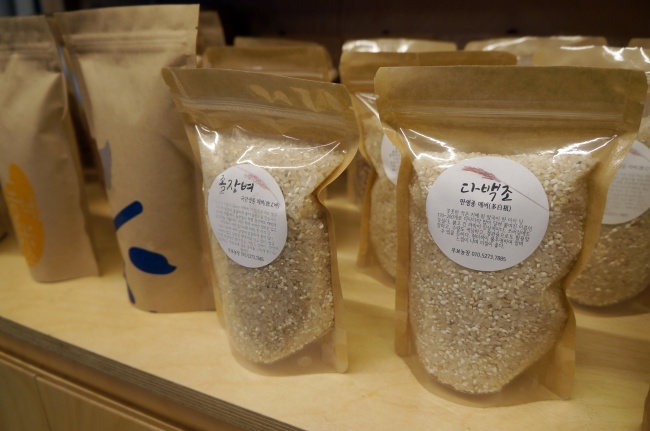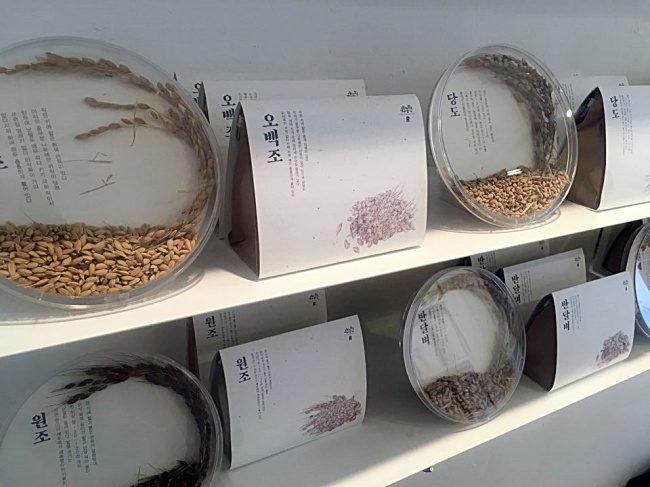Rice is under attack like it has never been before.
With growing health worries about the intake of refined carbohydrates and gluten, Koreans are eating less and less rice.
But at the same time, there is a growing number of rice lovers seeking out better taste, texture and nutrition.
Catering to the positive trend, a rice-only shop opened at Hyundai Department Store’s branch in Pangyo, in the southern suburbs of Seoul, in December.
The shop, one of four to open at the department store’s branches last year, specializes in high-end rice, or rice cultivars of fine quality that are 15 to 20 percent more expensive than ordinary ones. Well-known Japanese rice varieties such as Koshihikari are on the shelf.
Also waiting for guests at these stores are “rice sommeliers.”
Certified by a Japanese association, the experts make recommendations to consumers depending on their varying needs and explain the cultivars’ history, taste and characteristics. They also create rice blends.
At the Pangyo shop, a 5-kilogram sack of rice goes for around 30,000 won ($26.60).
The department store saw a growing market for premium rice despite the overall decline in rice consumption in Korea.
An average Korean consumed around 61.8 kilograms of rice in 2017, according to data from Statistics Korea, which translates to just about 170 grams a day. That is equivalent to just one package of Haetban instant white rice a day.
“Although the growth rate of total rice sales has been falling, consumers’ interest in premium rice is definite,” the company said in a press release.
Village Rice Mill is another high-end rice boutique. Located at Seongsan-dong, western Seoul, the establishment mills rice grains.
 |
Various rice varieties are on sale at Village Rice Mill in Seongsan-dong, Seoul. (Im Eun-byel / The Korea Herald) |
 |
(Im Eun-byel / The Korea Herald) |
Rice mills, which remove the husk and “polish” the grains, have been disappearing across the country as most people purchase milled rice at huge retail stores now. It is even harder to spot a rice mill in Seoul, as its residents live a highly industrialized life.
But Village Rice Mill opened its doors next to the busy Hongdae area in December 2017, hoping to revive rice’s status on the table.
Kim Dong-kyu, one of the owners of the store, calls himself a “rice curator.”
“We eat rice every day, but we know nothing about it,” Kim said. “This rice mill is about reviving the value of rice -- we should at least know something about what we are eating every day,” he said.
The rice mill also sells rice of various cultivars, packaged in small sizes under 450 grams. The packages cost around 3,000 won. They are all produced by independent farmers, small agricultural enterprises or co-ops.
To suggest a lifestyle, the rice mill also has a restaurant that serves steamed rice from its collection. The meal does not provide a fancy dining experience, but functions to show the importance of choosing the right rice.
With growing popularity, it opened another branch in the neighborhood in September.
“We hope more people can realize the importance of being aware of what you eat. The rice at supermarkets is labeled by the origin. Some even mistake the origins as the cultivars,” Kim said. “It is a process of finding taste. Like coffee, wine -- there are characteristics to each rice breed.”
For locavores, or those preferring local food over mass-produced products of multinational agricultural giants, native rice cultivars can be an optimal choice.
Woobo Farm is a community farm on the northwestern outskirts of Seoul that exclusively deals with native rice. Farmers cultivate around 100 native rice breeds at the 9,917-square-meter farm. The amount of harvest may not be as great as expected, though, as the native cultivars lack productivity.
According to farm owner Lee Geun-yi, the number of native rice cultivars rapidly dropped during Japanese occupation, as Japan enforced that farmers only cultivate highly productive breeds for rice exploitation.
“In the 1910s, it is recorded, there were about 1,500 native rice varieties cultivated across the Korean Peninsula. But by the time of the liberation (in 1945), the number had greatly decreased to around 450. Also, due to the government’s agriculture policies for rapid growth in the 1970s, most native rice seeds disappeared,” he said.
Most of the rice varieties on sale at supermarkets are crossbreeds. Imported seeds have been adapted to be usable under any circumstances. Nowadays, much of the rice consumed in Korea is white rice, which is sweet and high in carbohydrates.
But native rice varieties generally contain less carbs and more vitamins. They have distinctive flavors and mouthfeels. They can be mixed or cooked on their own.
 |
At Project Rent in Seongsu-dong, Seoul, 27 native rice varieties from Woobo Farm are currently on display. The exhibition continues until Monday. (Im Eun-byel / The Korea Herald) |
“Native rice has this natural beauty. It cannot be tamed. It is difficult to use machines when cultivating native rice cultivars. You have to use your hands,” Lee said.
Rice varieties from Woobo Farm are currently on display at Project Rent, a cultural space in Seongsu-dong, eastern Seoul. The exhibition showcases 27 native rice cultivars from Woobo Farm. It continues until Monday.
By Im Eun-byel (
silverstar@heraldcorp.com)










![[Today’s K-pop] Blackpink’s Jennie, Lisa invited to Coachella as solo acts](http://res.heraldm.com/phpwas/restmb_idxmake.php?idx=644&simg=/content/image/2024/11/21/20241121050099_0.jpg)